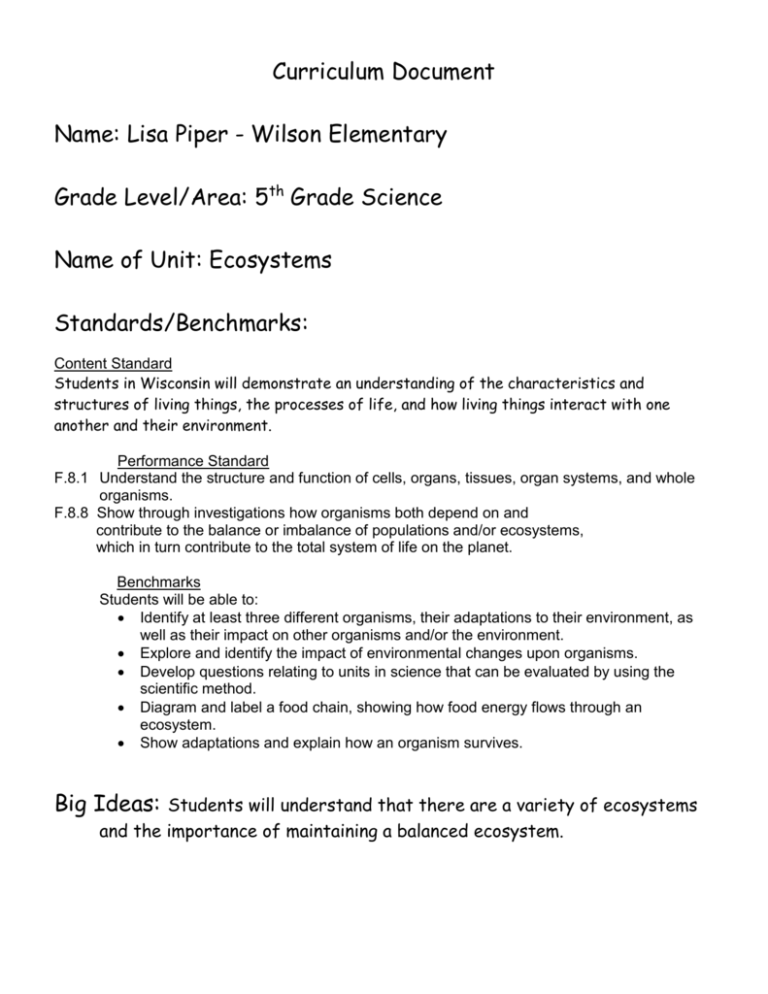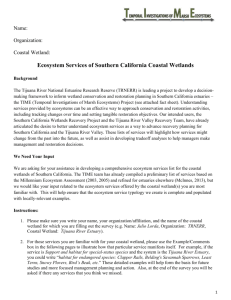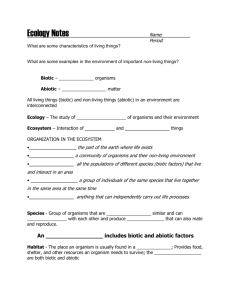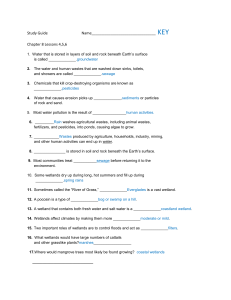Curriculum Document
advertisement

Curriculum Document Name: Lisa Piper - Wilson Elementary Grade Level/Area: 5th Grade Science Name of Unit: Ecosystems Standards/Benchmarks: Content Standard Students in Wisconsin will demonstrate an understanding of the characteristics and structures of living things, the processes of life, and how living things interact with one another and their environment. Performance Standard F.8.1 Understand the structure and function of cells, organs, tissues, organ systems, and whole organisms. F.8.8 Show through investigations how organisms both depend on and contribute to the balance or imbalance of populations and/or ecosystems, which in turn contribute to the total system of life on the planet. Benchmarks Students will be able to: Identify at least three different organisms, their adaptations to their environment, as well as their impact on other organisms and/or the environment. Explore and identify the impact of environmental changes upon organisms. Develop questions relating to units in science that can be evaluated by using the scientific method. Diagram and label a food chain, showing how food energy flows through an ecosystem. Show adaptations and explain how an organism survives. Big Ideas: Students will understand that there are a variety of ecosystems and the importance of maintaining a balanced ecosystem. Key Concepts/Key Questions: There are many types of ecosystems What are the functions and value of a wetland? Why are producers, consumers, and scavengers important? Why is it necessary for living things to have adaptations? Interdependence and the food chain Human impact on the environment (pollution) Skills, Knowledge, and Vocabulary to Understand the Content: Students will be able to… Find examples of producers, consumers and scavengers in an ecosystem. Use a map to communicate where various ecosystems are located. Label an animal’s adaptations and the importance of each adaptation. Create a food chain and label each component. Communicate ways to protect the wetlands. Students will know… Names and locations of some ecosystems. The functions of a wetland Why and how living and non-living things depend on each other. The effects (pollution) of humans on an ecosystem. How animals’ adaptations play a role in its survival. Vocabulary: adaptation, aqua, carnivores, consumers, decomposers, ecosystem, food chain, herbivores, interdependence, habitat, organism, photosynthesis, pollutant, producers, watershed, wetlands. Formative Assessments: 1. Students will verbally explain the relationship between producers, consumers and scavengers. 2. Students will list the functions of a wetland 3. Students will create a food chain. 4. Students will identify the effects of pollution on an ecosystem. 5. Students will draw or use technology to pick an animal and label the features it has to live in a certain environment (adaptations). Summative Assessments: 1. Wetlands Quiz 2. Wisconsin Wetlands Final Assessment 3. Students will create one of the technology choices and create a presentation to show what they learned. Learning Activities: (include performance tasks, differentiation, grouping, enrichment, reteaching, and materials) Lesson 1 – Intro/Pretest 1. Students will fill out a wetland web individually as a pretest. 2. Teacher will put the wetland web on inspirations and have whole group give answers to put on web. 3. View Bill Nye the Science Guy Wetlands video – whole group. Individually fill in “Know/New” chart and take quiz. 4. Using www.quizlet.com students play games, use flashcards, take tests using the pictures and definitions of the wetland glossary words: wetlands, swamp, bog, marsh, estuary, everglades. Teacher will show this as a whole group and when computers are available students can do it on their own. Lesson 2- Students will classify wetlands based on their characteristics. 1. As a whole group students will view my imovie about the different biomes. 2. With a partner, students will classify wetlands based on their characteristics using the Habitat Cards and flowchart. As students finish they will read the 3 types of Wetlands article. 3. As a whole group I will show the answers on the ELMO. Lesson 3 – Students will be able to play in maintaining our environment. identify at least five important functions wetlands 1. Each group of 4 will be given an object that has something to do with the functions of a wetland. As a team they will discuss the relationships between the object and a wetland. Students will record what they think. 2. Read “Subtle Protectors” in groups. 3. Give an opportunity for students to create a slideshow, movie etc. on the wetland functions and their metaphoric objects. 4. Students will list functions of a wetland. Lesson 4 – Students will describe the ability of wetland soils to filter pollutants from water. 1. Give each group of students a Scientific Method Sheet and have them fill in the problem, hypothesis and experiment. 2. As a class do the Nature’s Filter experiment and record results on Drainage Observations Chart. 3. Give students the opportunity to research how the Sheboygan Marsh is contributing to pollution control. 4. In groups have students finish Scientific Method Sheet (conclusion). Lesson 5 – Students will read about the aquarium plants and set up aquariums 1. With a partner students will read and highlight important information from “Duckweed, Elodea and algae: Why are they important?” 2. In groups students will put their aquatic plants into their aquariums and then fill out the “Observing the Aquarium sheet. 3. Individually students will draw and label what their aquarium looks like. 4. Give an opportunity to have students use flip camera to take picture of their aquarium daily to record their results. Lesson 6- Students will read about their aquarium animals and add them to aquariums 1. With a partner students will read “Guppies” and “Snails” and highlight important information. 2. In their groups students will put their guppies and snails in their aquariums. 3. Individually students will draw and label their animals in their aquariums. 4. Give an opportunity for students to go to Kidspiration and fill in the food chain science program and write their explanations. Lesson 7- Students will use the scientific method to understand the interdependence of wetland organisms. 1. In lab groups students will brainstorm possible experiment ideas and come up with an experiment. 2. Individually students will use the Internet to find information about the elements for their experiments. They will copy and paste the material they found onto a word document. 3. As a group students will share what they have found and form a hypothesis to be proved or disproved. 4. Individually students will fill out the scientific method sheet through the procedures. 5. As a group students will collect supplies needed to carry out their experiment. 6. Experiments will be started as soon as all students have their supplies. Daily observations will be made. Lesson 8 – Students will determine how organisms adapt for survival in an ecosystem. 1. Individually students will pick an animal and fill out the animal web found in packet. 2. Using the Internet students will individually research their animal and fill in “Critter Adaptations” sheet. 3. Individually students will go to www.tagxedo.com to make their animal and use words to describe their animals’ adaptations. Lesson 9- Students will describe interdependence using food chain vocabulary 1. Using www.quizlet.com students play games, use flashcards, take tests using the pictures and definitions of the food chain glossary words. 2. Students will find pictures on the internet of animals/plants in a food chain. Students will paste these in a word document and label each item in the food chain with the correct vocabulary words. 3. Take Wetland Quiz if the Marsh fieldtrip is completed. Lesson 10- Students will appreciate the interdependence of the organisms, including humans, involved in a food web. Students will also make the connection between the importance of natural resources and the ways we impact them. 1. Each student will pick a slip of paper with an organism’s name on it. The class will stand in a circle with their organism. One student will start with a ball of yarn and throw the string out to someone that has a organism that depends on him/her. This will continue until all students have gotten the yarn. 2. Whole class discussion on interdependence of organisms. Lesson 11- Students will design a picture of a food web 1. Each student will take what they had for lunch and design a food web using Kidspiration. Students will label each picture with consumer or producer. Lesson 12 – Students will describe six value categories (economic, aesthetic, recreation, education, egocentric, ecologic) and recognize examples of each. 1. With a partner, students will cut out the wetland value cards and paste them under the correct value category. Lesson 13 – Students will describe how humans impact the ecosystem 1. Splitting the class into three groups each group will read one of these articles: “The Story Behind Acid Rain”, “Crops and Cows – What’s the Problem?” or “When Salt Isn’t Safe”. 2. Each group will decide how they will explain the important parts of their article to the class. Students may choose to use technology or any other method they choose. Lesson 14- Students will demonstrate how pollution impacts our ecosystem and brainstorm possible ways of minimizing this effect. 1. As a large group students will define and discuss watershed. 2. In groups of 4 students will create landforms in their boxes, cover the lad forms, create a community and add some pollution. They will then make it rain. 3. As a large group we will discuss the results. Lesson 15- Students will review for the summative assessment. 1. Students will go to media center to play a jeopardy game on the SmartBoard. Due to time constraints we will play in groups of 5. Lesson 16- Students will take the summative assessment 1. Students who chose to “take the opportunity” to show their technology project will show them at this time. 2. Students will take the summative assessment individually. 3. As a challenge play “Who Wants to Be a Millionaire on Living Systems?”







